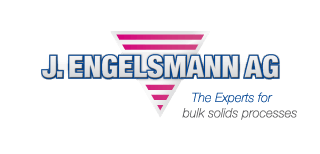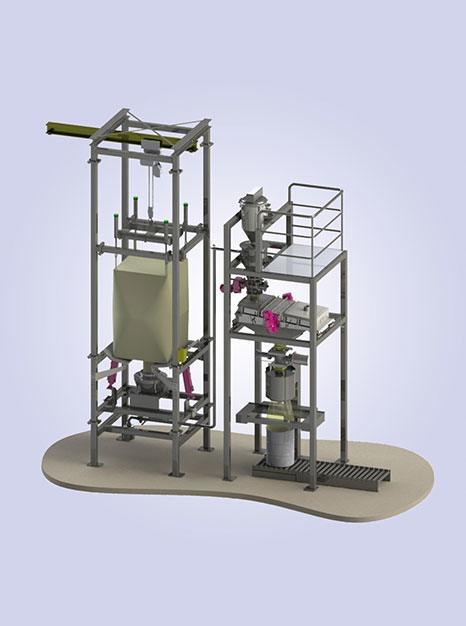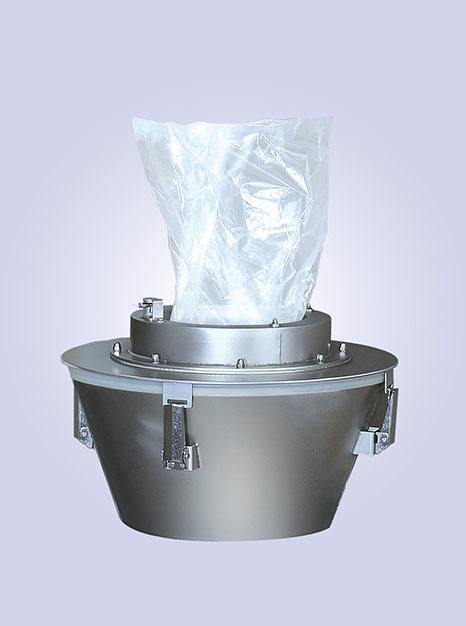Turnkey system for processing catalysts
Engelsmann plans, manufactures and instals processing plants for bulk solids all over the world – including screening, mixing, filling, discharging, conveying, dosing and weighing systems. The company develops turnkey plant solutions from the project definition created together with the client, to the planning and commissioning. The service provider also covers the relevant plant servicing, such as repairs, replacement parts service, training and plant optimisation.
A catalyser manufacturer for procedural applications was confronted with the task of having to transfer catalyser mixture into vessels to be able to feed this into the production process in smaller batch sizes. Due to the spatial conditions and to seal off other areas of the plant, the manufacturer had to siphon the product off over a distance of approx. 25 metres. The starting point for this procedural step is the modular big bag station for emptying big bags and transferring the product into the pneumatic conveyor system. Due to the different flow properties of the catalyser products, a pneumatic discharge aid is integrated into the emptying frame.
Connect safely and flexibly
The heart of the plant is the JEL Safe-Connect connecting system. It was in this case that the big bag could not be connected with a conventional and established discharge funnel and docking plate. Many customers often purchase the products they need from a multitude of different suppliers, meaning they have to contend with various discharge geometries and lengths. This is where the connection system of the manufacturer is connected: It is irrelevant whether the big bag has a long or short discharge outlet. Even differences in discharge diameter can be compensated. Easy connection is always possible within a tolerance of 50 mm. The system is available in different sizes and with different expansion modules. The manufacturer placed major importance on product and operating safety for these. Depending on the design, the user can avoid any contamination infiltrating from the outside, by rinsing or siphoning this off with compressed air or nitrogen before opening the entire plant section. Furthermore, the system secures any possible downstream dosing parts against intervention by the operator. The system enables safe and dust-free emptying of the product into the downstream process or into a feed pan.
Convey commercial products
The product is transported from this feed pan using the JEL Vacuu-Tec suction conveyor. The regulation of the air leakage rate or loading onto the conveyor line is carried out using the secondary air valve on the feed pan. A suction filter prevents impurities being sucked from the atmosphere. The conveying unit is designed especially for the conveying properties and adjusted to the conditions. To fulfil the requirements with regards products and conveying quantities, different sizes are available. The filter of the suction conveyor is assembled separately to the receptor. With the described system solution, the user must take the filter apart externally in a washroom and clean it. If needed, the manufacturer can make the unit CIP-capable. This makes it possible to react to changed conveying requirements without having to replace the complete suction conveyor system. To create the necessary low pressure, ventilators, side channel blowers and even vacuum pumps are available. The product is discharged from the suction conveyor and the downstream screening machine is dosed using the EZS rotary feeder. For ease of cleaning, this can be taken apart with just a few actions and the rotary valve can be removed from the side. A downstream Konti protective strainer avoids any possible impurities and agglomerate in the end product.
Increased safety in production
To avoid high reprocessing costs which are caused by sieve damage, the JEL Horus particle measuring device is installed on both discharge outlets of the screening machine. This means the particle flow can be monitored online and the particle size can be evaluated. If the sieve does breakdown or overrun, an alarm alerts the operator to possible damage in the filter material. The system works reliably with all free-flowing bulk solids in a grain size range of 150 µm to 6,000 µm. The supplied software of the self-cleaning system makes it possible to tailor the parame-terisation to the relevant product. An ATEX version is currently in development and will be available from the end of autumn 2012. Towards the end of the process, the system feeds the product into a vessel filling unit. This makes it possible to fill different vessel sizes. In this special case, this occurs in vessels which are designed with an inliner. This forms a continuous hose removed from a hose cartridge at the fill head. The inline is closed and separated by a welding device fitted to the filling scales. The advantage of the foil system is that the operator does not come into contact with the product. Furthermore, by including the product remains in the inliner, the continuous hose prevents any falling out (spillage) onto the floor.
Clean production environment due to trickling protection
If a continuous hose system is not used, the use of the JEL FlowStop trickling protector is recommended. The pneumatic protector has separated valve halves, which are situated on top of one another when open, meaning the side nearest the operator does not come into contact with the product. As this protector is “active” at the end of the connecting pipe, contamination is reduced to a minimum for the environment and the operator. If the filled containers are intended for trade, the filling procedure can take place in accordance with the relevant weights and measures act. All described plant components can also be designed and delivered by the manufacturer for the usual ATEX zones, if needed.
Engineering package from a single source
As well as pure plant construction, the company also offers the relevant engineering: This is divided into the fields of conceptual, basic and detailed engineering. Among other things, conceptual engineering includes the fields of project definition, development of procedural concepts, economic efficiency calculations and rough scheduling. Basic engineering deals with detailed procedural descriptions, basic procedural dimensioning, layout plans and cost estimations. The sector of detailed engineering is responsible for specifications and inquiries about equipment and component selection, P&I diagrams and 3D CAD plant plans. This part also includes the control system, measuring, control engineering and automation technology.








